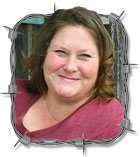In this edition of Ozarks Farm & Neighbor, we are saluting some of the hardest working people I know – the women in agriculture.
Many folks who aren’t involved in our industry, in my opinion, think women who live on farms are kind of like the dress-clad, hair and makeup always perfect June Cleaver, spending their days making sure the house is nice and clean, baking pies, keeping Beaver, Wally, Larry and Lumpy out of trouble, and having Ward’s dinner ready when he comes home from a hard day of work. Farm ladies don’t have a “real job” after all, so they have plenty of time in their day.
I thought all of you ladies reading would get a good laugh out of that. Not only do farm ladies have to tackle many, if not all, of the tasks above, there is also livestock to tend to, field work to do, fences to fix and everything else many in our society tend to think of as “man’s work.”
According to the 2012 Census in Agriculture, there are nearly 1 million women farmers in the U.S., and more than 288,000 of those women were the primary operator of their farming operation.
The report goes on to say that female principal operators sold $12.9 billion in agricultural products in 2012, including $6 billion in crop sales and $6.9 billion in livestock sales. They operated 62.7 million acres of farmland. Sales by women represented 3.3 percent of total U.S. agriculture sales, and women operate 6.9 percent of U.S. farmland. Not too shabby, ladies.
Let’s face it, most women – be it farm women, stay-at-home moms, women who work off the farm or outside the home – work hard, no matter what they do, in order to keep their homes and families happy and harmonious. I tell my four-legged kid just about every day that I would love to be a stay-at-home dog mom, but if I don’t go to work, no one gets fed, including her.
Some historians say women really came into their own as farmers and/or ranchers during the World War II era. Men were being called up to serve our country, leaving their wives and other female family members to carry on alone. I think, however, that women helped carve our farms out from the wilderness. Women, and children, worked long, physically demanding days along side of their husbands, fathers and brothers; it was a matter of survival.
After college, I took a job as a sports reporter in the Missouri River town of Lexington, Mo. In that small community stands one of only 12 Madonna of the Trail statues in the nation. The statues honor the pioneer mothers who traveled via covered wagon along the Santa Fe Trail. Dressed in a sun bonnet and long dress, the woman depicted in the 5-ton statues is holding a baby in her arm and a small boy is hanging onto her skirt; in her other hand is a rifle. If you look at the face of the woman, she isn’t scared. It is the face of a woman who is strong and knows that she has to do everything she can to protect her family.
If commissioned today to depict America’s women farmers and farm wives, that same look of determination and confidence would be seen.
Women such as the prominent 19th century cattlewoman Susan McSween and Margaret Borland, the first woman known to have ever lead a cattle drive, have helped to blaze a trail for women in farming and ranching. I see many more bright, shiny stars on the horizon in our industry being groomed on our family farms and in our agriculture education programs.
To the women in agriculture across the Ozarks, thank you for your dedication to your way of life. Thank you for not only helping to feed your family, but families around the world. Thank you for being a farmer.
Julie







